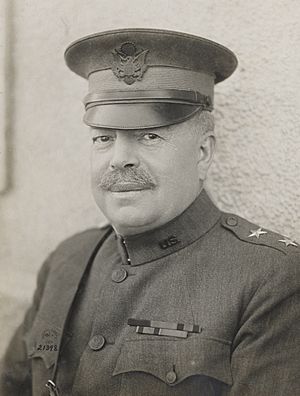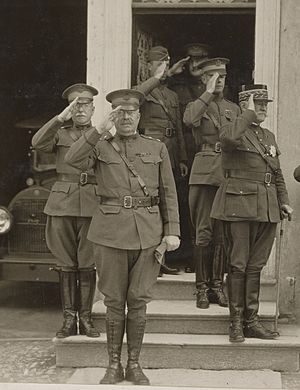Joseph T. Dickman facts for kids
Quick facts for kids
Joseph T. Dickman
|
|
|---|---|

Major General Joseph T. Dickman in October 1918
|
|
| Born | October 6, 1857 Dayton, Ohio, U.S. |
| Died | October 23, 1927 (aged 70) Washington, D.C., U.S. |
| Buried | |
| Allegiance | United States |
| Service/ |
United States Army |
| Years of service | 1883–1922 |
| Rank | Major General |
| Service number | 0-17 |
| Commands held | Third Army I Corps IV Corps 3rd Division 85th Division 2nd Cavalry Regiment |
| Battles/wars | Apache Wars
|
| Awards | Army Distinguished Service Medal Commander of the Legion of Honour (France) Croix de Guerre (France) Grand Officer of the Order of Leopold (Belgium) Grand Officer of the Order of the Crown of Italy Knight Commander of the Order of the Bath (United Kingdom) Medal of Solidarity (Panama) |
| Other work | Memoirs (1927) Translated General Von der Goltz's "Conduct of War" |
Joseph Theodore Dickman (born October 6, 1857 – died October 23, 1927) was a United States Army officer. He served in five different wars and became a major general.
Contents
Early Life and Education
Joseph Dickman was born in Dayton, Ohio. He went to the University of Dayton and finished his studies there in 1871. Later, in 1881, he graduated from the United States Military Academy at West Point. After graduating, he joined the 3rd Cavalry. Many of his classmates also became important generals.
Military Career
Early Service and Border Duty (1883–1898)
After graduating from the United States Army Cavalry School in 1883, Dickman went to the Indian territory. He fought in the Apache Wars from 1885 to 1886, including the Geronimo Campaign. He also helped patrol the Mexican border during the Garza Revolution.
From 1893 to 1894, Dickman was an instructor at the Cavalry and Light Artillery School at Fort Riley. In 1894, he was sent to help during the Pullman Strike in Chicago. Later that year, he was assigned to Fort Ethan Allen in Vermont.
Spanish–American War (1898–1900)
Dickman played an important role in the Spanish–American War. He fought in the Battle of San Juan Hill in Cuba. He also served with General Joseph Wheeler during the Philippine–American War from 1899 to 1902. He took part in battles on the Island of Panay.
Boxer Rebellion (1900)
During the Boxer Rebellion in China, Dickman was the chief of staff for General Adna Chaffee. He was part of the Peking Relief Expedition. He fought in the battle at Pa-ta-Chao, Peking, on September 26, 1900.
Between Wars (1902–1917)
Dickman worked on the Army General Staff from 1902 to 1905. He then taught at the Army War College from 1905 to 1912. From 1912 to 1915, he was the US Army Inspector General. In 1915, he took command of the 2nd US Cavalry. In August 1917, he was given command of the 85th Infantry Division at Camp Custer, Michigan.
World War I (1917–1918)
In November 1917, when the United States joined World War I, Dickman was given command of the 3rd Infantry Division. He took the 3rd Division to France on the ship Leviathan on March 4, 1918.
He was the commander of the 3rd Division at the Chateau-Thierry in May 1918. He became famous during the Second Battle of the Marne in July 1918. While other allied forces had to retreat, Dickman's 3rd Division held its ground against enemy attacks. This earned them the nickname "The Rock of the Marne."
Dickman then commanded IV Corps from August to September 1918. This included the Saint-Mihiel Offensive. After that, he commanded I Corps from October to November 1918, which included the Meuse-Argonne Offensive.
General John J. Pershing created the Third Army under Dickman's command in France. Their job was to advance to the Rhein River and hold the Coblenz bridgehead. They were also ready to serve as the Army of Occupation after the war. This Third Army would have occupied the Rhineland even if Germany had not signed the peace agreement. American fighting units that were not sent home joined the Third Army. They were prepared to attack if Germany did not accept the peace terms. The United States did not sign the peace agreement for two more years, so it was technically still at war with Germany.
After the War
After World War I, Dickman returned to the U.S. He was president of the Tactics and Organization Board from April to July 1919. This board studied what was learned during the war. Dickman then served as commanding general of the VIII Corps Area from 1919 to 1921. He retired from the army on October 6, 1921.
In 1922, he was called back to lead a board that helped reduce the size of the army after the war. His own memories of the war were published in a book in 1927.
Joseph Dickman passed away in Washington, D.C., on October 23, 1927. He was buried at Arlington National Cemetery.
Awards and Decorations
Joseph T. Dickman received many awards for his service:
- American awards
| Army Distinguished Service Medal | |
| Indian Campaign Medal (for the Geronimo Campaign) | |
| Spanish Campaign Medal | |
| Army of Cuban Occupation Medal | |
| Philippine Campaign Medal | |
| China Campaign Medal | |
| Mexican Border Service Medal | |
| World War I Victory Medal (United States) (with six battle clasps) |
- Foreign awards
| Croix de Guerre with palm (France) | |
| Grand Officer of the Order of Leopold I (Belgium) | |
| Knight Commander of the Order of the Bath (Britain) | |
| Commander of the Order of the Legion of Honour (France) | |
| Grand Officer of the Order of the Crown (Italy) | |
| Medal of Solidarity (Panama) |
He also received an honorary degree (LL.D.) from the University of Vermont.
Published Works
- Dickman, Joseph Theodore. The Great Crusade. A Narrative of the World War. NY: Appleton, 1927. This book tells about his experiences in World War I.
- He also translated General Von der Goltz's book "Conduct of War."


